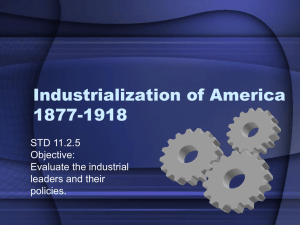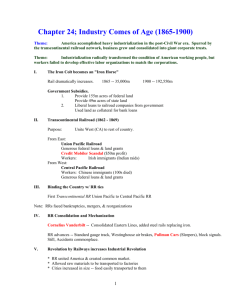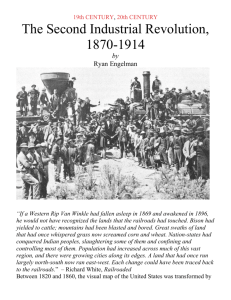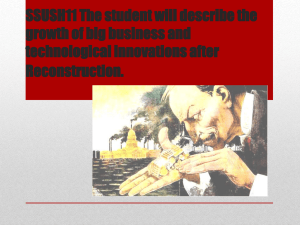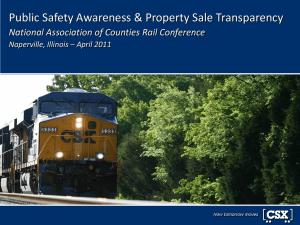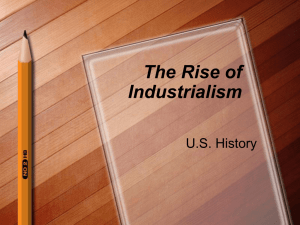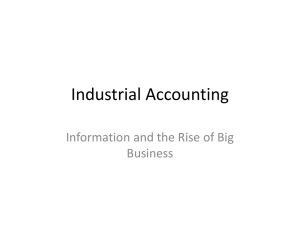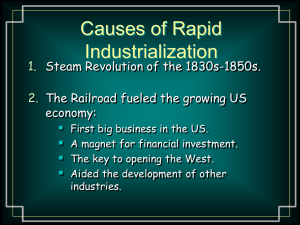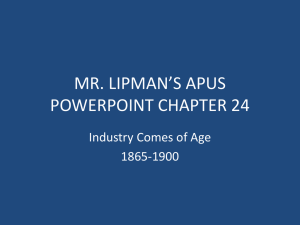Second Industrial Revolution - Somerset Academy Silver Palms
advertisement
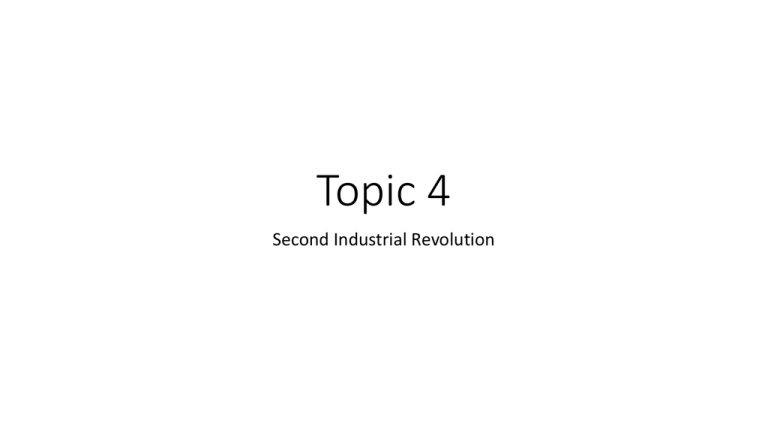
Topic 4 Second Industrial Revolution Standard • SS.912.A.3.2-Industrial Revolution: Examine the social, political, and economic causes, course, and consequences of the Second Industrial Revolution that began in the late 19th century. Also Assessed • SS.912.A.3.3: Compare the first and second Industrial Revolutions in the United States. • SS.912.A.3.4: Determine how the development of steel, oil, transportation, communication, and business practices affected the United States economy. • SS.912.A.3.5: Identify significant inventors of the Industrial Revolution including African Americans and women. • SS.912.A.3.7: Compare the experience of European immigrants in the east to that of Asian immigrants in the west (the Chinese Exclusion Act, Gentlemen's Agreement with Japan). • SS.912.A.3.8: Examine the importance of social change and reform in the late 19th and early 20th centuries (class system, migration from farms to cities, Social Gospel Movement, role of settlement houses and churches in providing services to the poor). • SS.912.A.3.9: Examine causes, course, and consequences of the labor movement in the late 19th and early 20th centuries. • SS.912.A.3.10: Review different economic and philosophic ideologies. • SS.912.A.3.11: Analyze the impact of political machines in United States cities in the late 19th and early 20th centuries. • SS.912.A.3.12: Compare how different nongovernmental organizations and progressives worked to shape public policy, restore economic opportunities, and correct injustices in American life. • SS.912.A.3.13: Examine key events and peoples in Florida history as they relate to United States history. September 26-29 • SS.912.A.3.3: Compare the first and second Industrial Revolutions in the United States. • SS.912.A.3.5: Identify significant inventors of the Industrial Revolution including African Americans and women. Patent • Patent-sole legal rights to an invention and its profits First and Second Industrial Revolution • • • • First Industrial Revolution (1790s-1840s) 1. Common sources of power included wind, horse, man, and water. 2. Marked the change from the home system to the factory system 3. Started by Eli Whitney, Samuel Slater, and others who developed simple machines and factories to create fabric, and machine parts. • 4. Confined to New England because New England had mountains, which offered waterfalls, which offered power. • 5. Pulled women off the farms to work in factories, the most famous of which was that located in Lowell, Massachusetts (started by Francis Lowell) • 6. Helped lead to the Second Great Awakening in which reformers attempted to reform society of the evils this interest in marketing and money created. Women, children, slaves, and immigrants were helped by reformist causes at this time First and Second Industrial Revolution • Second Industrial Revolution (1870-1910) • 1. Started as a result of the increased demand for goods following the Civil War with the rebuilding of the South, the building of the railroads west, and the move off the farm to the cities in the north • 2. Involved gasoline-powered motors and electrical-powered engines and turbines. • 3. FACTORIES now took the place of small shops with one or two machines. Now the workers had to adapt to the factory and not the factory adapt to the worker • 4. Led by John C. Rockefeller, Andrew Carnegie, Cornelius Vanderbilt, J.P. Morgan, and Thomas A. Edison. • 5. Thanks to the electric light now factories could stay open for 24 hours if necessary to pump out an endless stream of goods. • 6. Led to the age of overseas imperialism and expansion as America needed larger and larger markets in which to sell these goods and FROM which to extract the raw materials necessary to power these growing factories • 7. Led to the Progressive Movement in which reformers attempted to clean up the evils brought on by the thirst for wealth and power generated by the above-mentioned 'robber-barons.' Significant Inventors • Person-Invention-Date • James Watt- First reliable Steam Engine 1775 (most important) • Eli Whitney Cotton Gin-Interchangeable parts for muskets 1793, 1798 • Robert Fulton-Regular Steamboat service on the Hudson River 1807 • Samuel F. B. Morse- Telegraph 1836 • Elias Howe- Sewing Machine 1844 • Isaac Singer- Improves and markets Howe's Sewing Machine 1851 • Cyrus Field- Transatlantic Cable 1866 • Alexander Graham Bell- Telephone 1876 • Thomas Edison ("Wizard of Menlo Park")Phonograph, incandescent Light Bulb, motion picture machine 1877, 1879 • Nikola Tesla- Induction Electric Motor 1888 • Rudolf Diesel- Diesel Engine 1892 • Orville and Wilbur Wright- First Airplane 1903 • Henry Ford Model T Ford, Assembly Line 1908, 1913 • Peter Cooper built the first steam locomotive African Americans and Women • Elijah McCoy, an African-American inventor, invented an oil-dripping cup for trains (1872). • Other inventors tried to copy McCoy's oil-dripping cup. But none of the other cups worked as well as his, so customers started asking for "the real McCoy." That's where the famous expression comes from. • Madam C. J. Walker, and African-American woman, invented a hairgrowing lotion for black woman to use in order to relax their hair. Walker grew up poor. But she became the first female AfricanAmerican millionaire. By 1916, she employed over 20,000 African American women across the country • Sarah E. Goode was the first African-American woman to receive a patent for her invention of the cabinet bed in 1885. • Inventor Mary Anderson received a patent for her car-window cleaning device in 1903. She invented window wipers. September 30 • SS.912.A.3.4: Determine how the development of steel, oil, transportation, communication, and business practices affected the United States economy. • SS.912.A.3.13: Examine key events and peoples in Florida history as they relate to United States history. United States Industrializes • Reasons: 1. Natural resources 2. Large workforce (immigrants and bigger families/longer life expectancy)=more workers/more consumers 3. New inventions 4. Free enterprise=laissez faire 5. Investment by wealthy Americans and Europeans 6. High Tariffs to protect American business Vocabulary • Gross national product-the total value of all goods and services that a country produces during a year • Kerosene-a fuel used in lanterns and stoves • laissez-faire economics-government should not be interfere in the economy other than to protect property rights and maintain peace • Entrepreneur-people who risk their capital to organize and run businesses • Robber baron- industrialists who grew wealthy unethically • Corporation-organization owned by many people and treated by law as a person Business Practices • Pool-informal agreement by competing companies to fix prices, share profits, or divide the market for their products • Trust-companies legally joining together to reduce competition • Monopoly-total control of an industry • Sherman Anti-Trust-passed in 1890-made trust agreements illegal • Holding Company-didn’t make or sell anything but was created to own majority of many companies and make its decisions • Vertical Integration-owning everything from the raw materials to sales • Horizontal Integration- growth by buying competition Advantages of Big Business • Build modern plants • Get the most up to date machinery • Buy large amounts of raw materials • Conduct scientific research • Nationwide network • Advertise Disadvantages of Big Business • Became monopolistic • Destroyed competition • Drive out small business • Give too much power to the few owners • Give them power to corrupt politics Mass Production • Standardized parts • Assembly line • Labor saving machinery • Division of labor • Laissez faire economics attracted entrepreneurs • The US kept taxes low (laissez faire) but promoted private investment (involved in economy) • Tariffs were used to protect some but it hurt others • Tariffs money was used to help companies build roads, railroads, and canals • During the Civil War, Congress greatly increased tariff rates on imports, causing other countries to raise their tariffs on US goods. This hurt companies trying to sell goods internationally. When companies became larger and more competitive tariffs were lowered. Communication Cyrus Field laid a telegraph cable across the Atlantic Ocean enabling faster communication with Europe Alexander Graham Bell invented the telephone, revolutionizing communication Railroads • 1865-35,000 miles of railroad track • 1900-200,000 miles of railroad track • Transcontinental Railroad brought in 10,000 Chinese workers from China and paid them $1 a day • Many other railroads started crossing the nation • Railroad companies also stimulated the economy by buying steel, coal, and timber • Railroad companies started combining themselves and made one integrated system • Freight cost dropped • American Railway Association divided the country into 4 times zones in 1883 • Most investors could not raise the money to build railroads. The government gave land grants to many railroad companies. This free land was later sold by the companies to raise money for construction. • Cornelius Vanderbilt and Jay Gould were railroad entrepreneurs • Some investors, robber barons, began bribing members of Congress for grants Railroad abuses • charging excessive rates • charging more for carrying freight over short distances, where there were no competing railroads, than for long hauls in competitive territory • granting rebates (refunds) to large shippers • obtaining legislation favorable to their interests by political activity, bribery, and corruption. Led to • the Granger Movement took political action. They convinced some states to pass laws regulating railroad activity. By 1887, Congress passed the Interstate Commerce Act. The act gave the federal government even more power over the railroads by regulating their commercial practices and rates. Florida • Henry Flagler built bridges to the Florida Keys and rail lines to St. Augustine. He built a luxury hotel which attracted wealthy guests • Henry Plant coordinated several rail line connections that ended in Tampa. He also built a luxury hotel. • William Chipley built railroads across the Florida Panhandle, connecting it to the Atlantic Coast for the first time Steel • Steel made out of iron through Bessemer process where cold air is forced through molten iron to remove its impurities. Then some carbon is added to create a tough and elastic steel. • Steel soon became the basic material of the economy -- used for rails, trains, machinery, wire, pipe, bridges, frameworks for buildings, ships, automobiles, and innumerable consumer products Andrew Carnagie • Andrew Carnegie-Steel King, he used vertical and horizontal integration. • His success started the theory of Social Darwinism • A contrary principle started by Carnegie is the “Gospel of Wealth” Oil • American oil industry was built on the demand for kerosene. The industry began in Pennsylvania where oil was found. • In 1859 Edwin Drake drilled the first oil well by 1900 there were oil fields from Pennsylvania to Texas • A rise in oil production led to economic expansion • John D Rockefeller controlled 90% of oil in US in 1880 Finance • J. Pierpont Morgan was the owner of the largest private banking and securities house in America. He reorganized many bankrupt railroads during the late 19th century. In 1901, Morgan and his associated purchased the Carnegie Steel Company and merged it with other steel producers to form the enormous monopoly known as the United States Steel Corporation. This was the nation's first billiondollar company. Meat Packing • Philip D. Armour, Nelson Morris, and Gustavus Swift were all important pioneers in the development of the meat-packing industry, which was located in Chicago and other Midwestern cities close to the cattle raising areas. Here, great numbers of pigs and cows were slaughtered and prepared for market. Here, great numbers of pigs and cows were slaughtered and prepared for market. Tobacco • James Duke and his brother Benjamin formed the American Tobacco Company. They absorbed their competitors by threatening to ruin them through price wars. The huge tobacco and cigarette trust that they built was ordered dissolved by the Supreme Court in 1911. Chemicals • The DuPont family started manufacturing gunpowder in Delaware in 1801. Later, the DuPont Company became one of the world's leading companies in the development and manufacturing of chemicals, dyes, plastics, and synthetic fibers. Retailing techniques change • Before you had to go to a store that made the thing you wanted or a general store where you bought food, tools, most of the time in bulk Then came: • Specialty shops-one specific product being sold • Chain stores-various locations • Department stores-all goods in separate departments • Selling by mail • Advertising, marketing, packaging • During the Industrialization Era in the late 19th century, corporations were able to form into monopolies • In the late 1800s, workers received low wages because they could easily be replaced • Industrialization affected the United States by increasing population • According to the Gospel of Wealth espoused by Andrew Carnegie, the rich have a responsibility of philanthropy • Social Darwinists believed that only the strong survive

